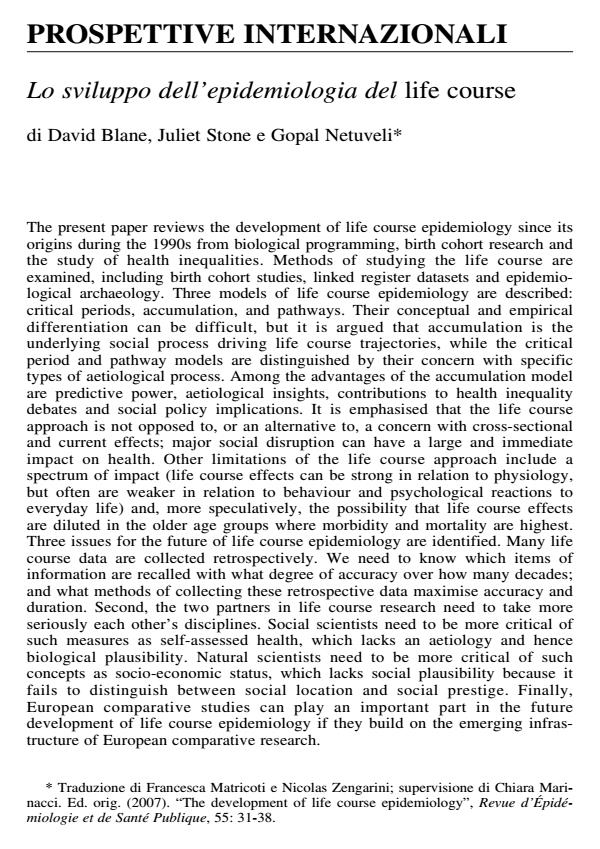Lo sviluppo dell’epidemiologia del life course
Journal title SALUTE E SOCIETÀ
Author/s David Blane, Juliet Stone, Gopal Netuveli
Publishing Year 2009 Issue 2009/1
Language Italian Pages 19 P. 171-189 File size 88 KB
DOI 10.3280/SES2009-001015
DOI is like a bar code for intellectual property: to have more infomation
click here
Below, you can see the article first page
If you want to buy this article in PDF format, you can do it, following the instructions to buy download credits

FrancoAngeli is member of Publishers International Linking Association, Inc (PILA), a not-for-profit association which run the CrossRef service enabling links to and from online scholarly content.
Lo sviluppo dell’epidemiologia del life course - The present paper reviews the development of life course epidemiology since its origins during the 1990s from biological programming, birth cohort research and the study of health inequalities. Methods of studying the life course are examined, including birth cohort studies, linked register datasets and epidemiological archaeology. Three models of life course epidemiology are described: critical periods, accumulation, and pathways. Their conceptual and empirical differentiation can be difficult, but it is argued that accumulation is the underlying social process driving life course trajectories, while the critical period and pathway models are distinguished by their concern with specific types of aetiological process. Among the advantages of the accumulation model are predictive power, aetiological insights, contributions to health inequality debates and social policy implications. It is emphasised that the life course approach is not opposed to, or an alternative to, a concern with cross-sectional and current effects; major social disruption can have a large and immediate impact on health. Other limitations of the life course approach include a spectrum of impact (life course effects can be strong in relation to physiology, but often are weaker in relation to behaviour and psychological reactions to everyday life) and, more speculatively, the possibility that life course effects are diluted in the older age groups where morbidity and mortality are highest. Three issues for the future of life course epidemiology are identified. Many life course data are collected retrospectively. We need to know which items of information are recalled with what degree of accuracy over how many decades; and what methods of collecting these retrospective data maximise accuracy and duration. Second, the two partners in life course research need to take more seriously each other’s disciplines. Social scientists need to be more critical of such measures as self-assessed health, which lacks an aetiology and hence biological plausibility. Natural scientists need to be more critical of such concepts as socio-economic status, which lacks social plausibility because it fails to distinguish between social location and social prestige. Finally, European comparative studies can play an important part in the future development of life course epidemiology if they build on the emerging infrastructure of European comparative research. Key words: life course epidemiology, life course trajectories, life course data, social inequalities, accumulation model, socio-economic status. Parole chiave: epidemiologia del corso di vita, traiettorie di vita, dati del corso di vita, disuguaglianze sociali, modello di accumulazione, status socio-economico
David Blane, Juliet Stone, Gopal Netuveli, Lo sviluppo dell’epidemiologia del life course in "SALUTE E SOCIETÀ" 1/2009, pp 171-189, DOI: 10.3280/SES2009-001015